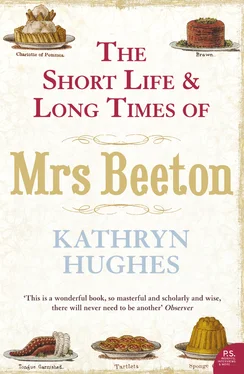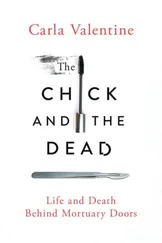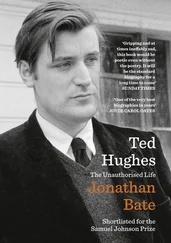Such misdirections and inaccuracies aside, a gratifyingly large number of letters arrived at High Lands, Beeton’s Surrey villa, in response to the piece in the Mail . One was from an Old Marlburian who had been at school with Beeton over fifty years previously, expressing his surprise that ‘Curiously enough I never connected the book with you’, voicing a common elision between the flesh and blood ‘Mrs Beeton’ and the one that was made out of 1,000 pages of closely printed paper, and handsome calf binding. An elderly gentleman wrote with fond memories of ‘messing’ with Mrs Beeton’s recipes during his childhood in the 1860s. One British woman wrote from Paris to say that her New Zealander husband had presented her as a young bride with a Mrs Beeton in recognition of the fact that his parents had relied on it during some tough years in a lonely sheep station. Other notes arrived from correspondents who had known various members of the extended Beeton and Dorling clans in days gone by and wanted Sir Mayson to verify various dimly remembered anecdotes. Had the famous book not been written in Greenhithe where Mrs Beeton lived for the last year of her life? Surely the great work had been completed while she was sitting on a bench in the garden of Ashley House, her stepsister’s large Epsom residence?
To all these correspondents Mayson Beeton dutifully responded. ‘Wrote a chatty letter’, ‘replied with thanks’ is regularly written in pencil across the top of incoming mail. To those who asked for it, he enclosed a copy of the National Portrait Gallery postcard. And, such being the good manners of the day, the recipients inevitably wrote back thanking him for his kindness and complimenting him on his mother’s ‘beautiful’, ‘charming’, ‘kind’, ‘sweet’, ‘romantic’ and, above all, ‘Victorian’ face. To those correspondents who wrote offering photographs and recollections of his parents’ families Beeton was especially warm, inviting them to ‘run down’ to High Lands for a visit. For by now Beeton had decided that the time was right for him to write a proper ‘memoir’ of his parents and he needed all the extra material he could scavenge if he was to produce something that would stretch to the length of at least a small book.
There was never any doubt in Beeton’s mind as to who was going to write the biography of his parents. Although the documentary evidence in his possession was, on his own admission, ‘scanty’, he knew there were still plenty of awkward stories and embarrassing rumours about his parents’ life at large that would need to be deftly despatched. These would need careful handling, and Beeton had no intention of letting an outsider clamber over the project, leaking secrets in the process. He had already had to deal with one particularly annoying young woman called Joan Adeney Easdale, who seemed determined to write a biography of Mrs Beeton, with or without his approval. In the many letters Beeton fired off to producers and editors in the mid 1930s urging them to have nothing to do with Miss Easdale’s work, he always returns to the fact that it is his parents’ ‘private family life’ (the underlining is his) that he is determined to protect from the impertinent and uncomprehending gaze of strangers.
With Miss Easdale’s cautionary example in mind, Mayson Beeton dealt particularly firmly with the steady stream of lady writers who contacted him in the wake of the 1936 Daily Mail article asking for his blessing on their intention to put together a biography of his mother. To correspondents such as Winifred Valentine (Mrs), Mrs Sheriff Holt, and Mary Stollard (Miss), Beeton wrote back stiffly, discouraging any hope that he might be about to turn his precious cache of material over to them. If they wished to publish a short biographical article on Mrs Beeton in the Woman’s Magazine or the Lady or the Nursing Times he would not stop them, but he asked that they submit a proof to him first. Quite sensibly they did not, which meant that Beeton was then able to work himself up into a delicious frenzy when their chatty, anodyne pieces finally appeared. ‘Full of Inaccuracies!’ is scrawled across the top of pieces that, notwithstanding his contempt, have been pasted onto stiff card and carefully dated for posterity.
To those male, and on the whole better known, authors who wrote sounding Beeton out about the possibility of taking on his mother’s biography, he tended to use a more gentlemanly tone. Responding to the professional biographer Osbert Burdett who had made contact in April 1936, Beeton explained that he was planning to do the job himself. In addition he told Burdett what he does not seem to have told any of his lady correspondents, that he was going to be using a collaborator. Although Beeton had started his working life in magazine journalism, by the age of 35 he had shifted permanently into management. It was years since he had done any writing and the Daily Mail piece had proved an arduous task. In any case, he was now 70 years old and needed someone to do the footslogging in the central London libraries that was increasingly beyond him.
What Beeton needed above all was someone who could be relied upon to be discreet. There were things in his parents’ story that he was determined should not be put before the public, and he had to be certain that the person he worked with understood this. The chosen candidate also needed to realize that a key purpose of this ‘memoir’ was to rescue Samuel Beeton’s professional legacy from the long shadow cast over it by his wife’s flukish achievement. Which is why Sir Mayson’s choice of collaborator fell upon a young man who was actually related to him through his paternal, that is Beeton, line. Harford Montgomery Hyde was a 30-year-old barrister and professional writer whose great aunt had been married to Samuel Beeton’s second cousin and whom Sir Mayson had known since he was a boy. Hyde had already published a couple of books since leaving Oxford where, like Beeton, he had been at Magdalen. But, most important of all, he had a reputation for a tenacious yet discreet approach to research: ‘Montgomery the Mole’ would become his nickname in wartime intelligence ‘because I had the reputation of burrowing away among historical documents and discovering other people’s secrets’.
Through the late 1930s Hyde went on ‘prospecting operations’ for Sir Mayson, wading through administrative and legal records in Guildhall and Chancery to see if he could uncover any official information to supplement the family documents stored by Beeton in a series of japanned boxes at High Lands. No start, however, seems to have been made on the actual writing of the book and, just when things might really have got going, the war changed everything. Hyde went to the US where he worked in counter-espionage, and Beeton shifted his focus from family matters to national ones. The last war had been his finest hour, with his work for the Finance Department of the Ministry of Munitions partly responsible for netting him a knighthood in 1920. That sort of active public role may have been beyond him now, but Beeton was still determined to be useful. It was his fond hope that, should London be flattened by German bombs, his vast archive of antiquarian maps and topographical prints could provide the basis for the capital’s rebuilding. Thus, much of Beeton’s energy in 1941 was spent arranging with Lord Reith to have his collection transferred to the Ministry of Works and Buildings, now temporarily housed in the relative safety of Oxfordshire. Letters Beeton wrote at this time make it clear that he was still fully intending to write his parents’ ‘memoir’. However when Lady Beeton died two years later after fifty years of happy marriage, the old man found himself emotionally winded and suddenly frail. For the first time in his life he was ready to consider passing over the custodianship of his parents’ reviving reputation to someone else.
Читать дальше












